inflation pressure Hyundai Terracan 2006 Owner's Manual
[x] Cancel search | Manufacturer: HYUNDAI, Model Year: 2006, Model line: Terracan, Model: Hyundai Terracan 2006Pages: 539, PDF Size: 18.11 MB
Page 64 of 539
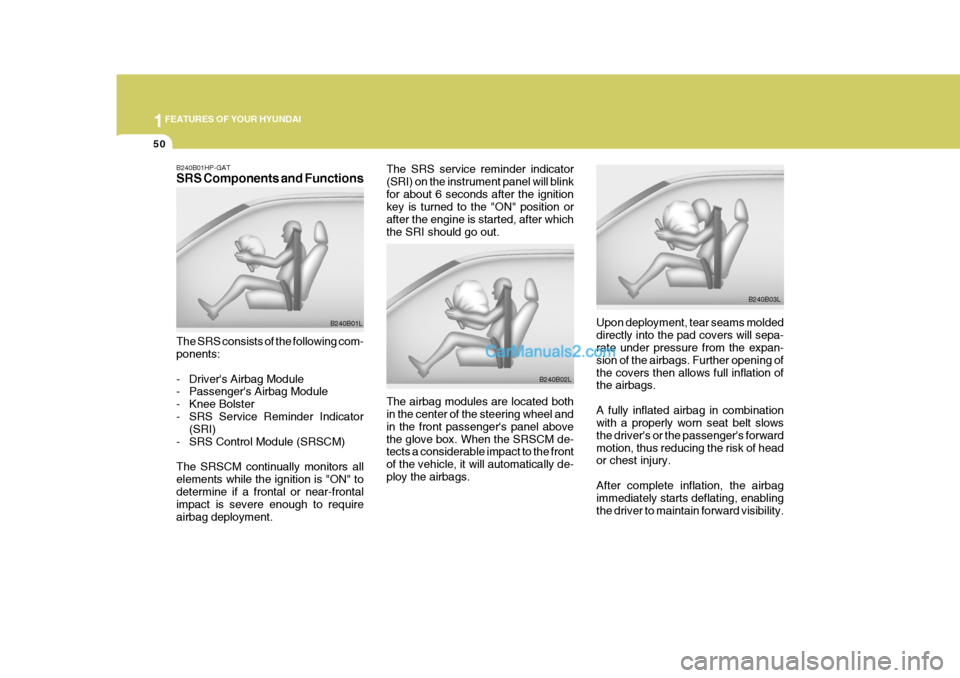
1FEATURES OF YOUR HYUNDAI
50
The SRS service reminder indicator (SRI) on the instrument panel will blinkfor about 6 seconds after the ignition key is turned to the "ON" position or after the engine is started, after whichthe SRI should go out.
Upon deployment, tear seams moldeddirectly into the pad covers will sepa- rate under pressure from the expan- sion of the airbags. Further opening ofthe covers then allows full inflation of the airbags. A fully inflated airbag in combination with a properly worn seat belt slows the driver's or the passenger's forwardmotion, thus reducing the risk of head or chest injury. After complete inflation, the airbag immediately starts deflating, enabling the driver to maintain forward visibility.
The airbag modules are located both in the center of the steering wheel and in the front passenger's panel abovethe glove box. When the SRSCM de- tects a considerable impact to the front of the vehicle, it will automatically de-ploy the airbags.
B240B02L
B240B03L
B240B01HP-GAT SRS Components and Functions The SRS consists of the following com- ponents:
- Driver's Airbag Module
- Passenger's Airbag Module
- Knee Bolster
- SRS Service Reminder Indicator
(SRI)
- SRS Control Module (SRSCM) The SRSCM continually monitors all elements while the ignition is "ON" todetermine if a frontal or near-frontal impact is severe enough to require airbag deployment. B240B01L
Page 182 of 539
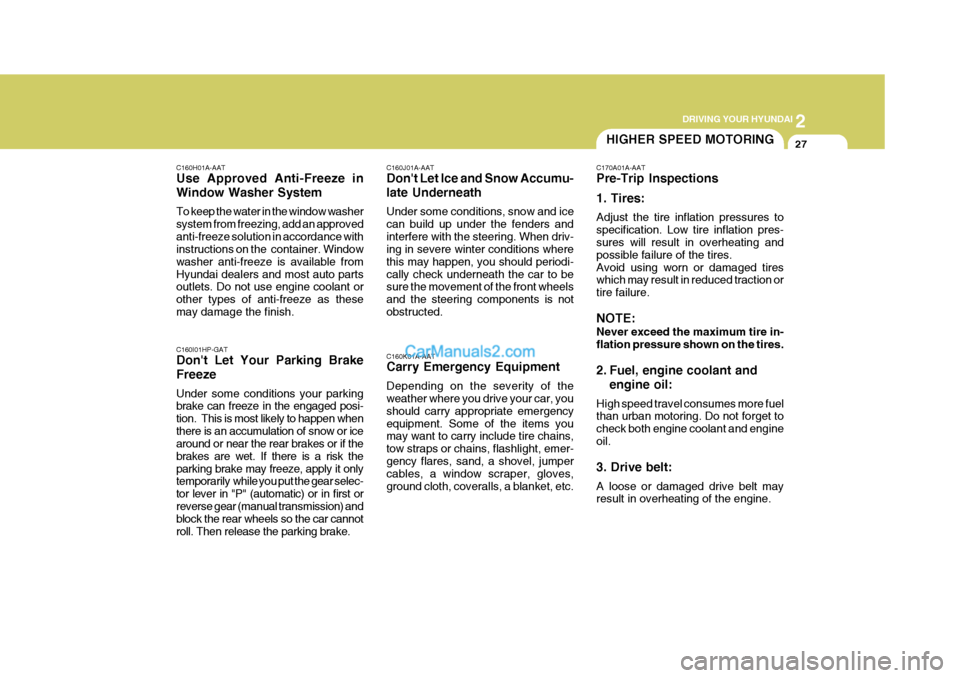
2
DRIVING YOUR HYUNDAI
27
C160H01A-AAT Use Approved Anti-Freeze in Window Washer System To keep the water in the window washer system from freezing, add an approvedanti-freeze solution in accordance with instructions on the container. Window washer anti-freeze is available fromHyundai dealers and most auto parts outlets. Do not use engine coolant or other types of anti-freeze as thesemay damage the finish. C160I01HP-GAT Don't Let Your Parking Brake Freeze Under some conditions your parking brake can freeze in the engaged posi- tion. This is most likely to happen whenthere is an accumulation of snow or ice around or near the rear brakes or if the brakes are wet. If there is a risk theparking brake may freeze, apply it only temporarily while you put the gear selec- tor lever in "P" (automatic) or in first orreverse gear (manual transmission) and block the rear wheels so the car cannot roll. Then release the parking brake. C160K01A-AAT Carry Emergency Equipment Depending on the severity of the weather where you drive your car, you should carry appropriate emergencyequipment. Some of the items you may want to carry include tire chains, tow straps or chains, flashlight, emer-gency flares, sand, a shovel, jumper cables, a window scraper, gloves, ground cloth, coveralls, a blanket, etc.HIGHER SPEED MOTORING
C170A01A-AAT Pre-Trip Inspections 1. Tires: Adjust the tire inflation pressures to specification. Low tire inflation pres- sures will result in overheating and possible failure of the tires.Avoid using worn or damaged tires which may result in reduced traction or tire failure. NOTE: Never exceed the maximum tire in- flation pressure shown on the tires.
2. Fuel, engine coolant and engine oil:
High speed travel consumes more fuel than urban motoring. Do not forget to check both engine coolant and engineoil. 3. Drive belt: A loose or damaged drive belt may result in overheating of the engine.
C160J01A-AAT Don't Let Ice and Snow Accumu- late Underneath Under some conditions, snow and ice can build up under the fenders andinterfere with the steering. When driv- ing in severe winter conditions where this may happen, you should periodi-cally check underneath the car to be sure the movement of the front wheels and the steering components is notobstructed.
Page 192 of 539
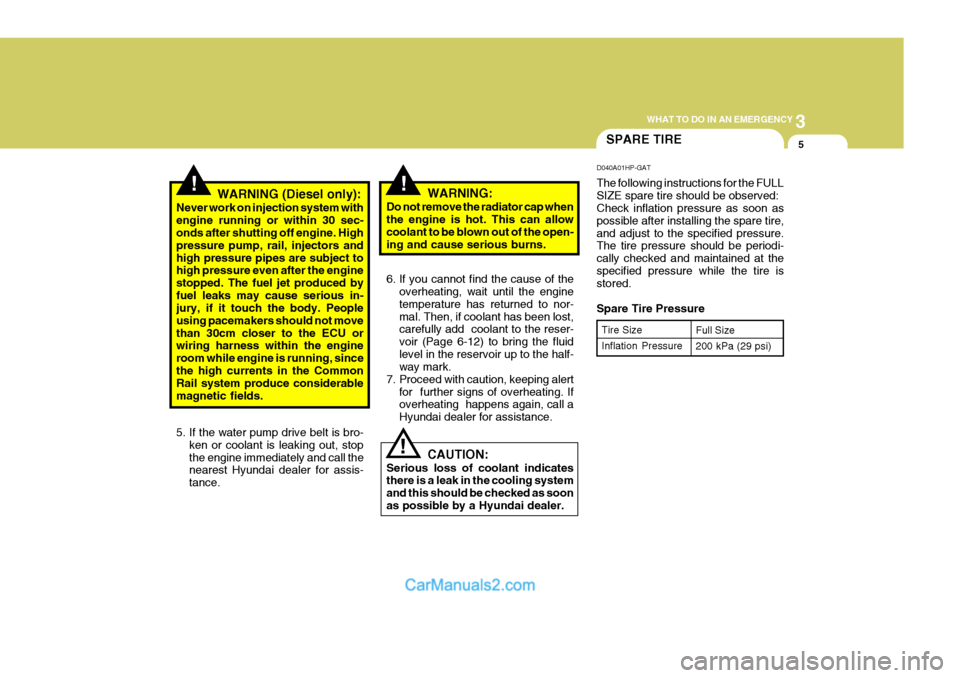
3
WHAT TO DO IN AN EMERGENCY
5SPARE TIRE
!
!!WARNING (Diesel only):
Never work on injection system with engine running or within 30 sec- onds after shutting off engine. High pressure pump, rail, injectors andhigh pressure pipes are subject to high pressure even after the engine stopped. The fuel jet produced byfuel leaks may cause serious in- jury, if it touch the body. People using pacemakers should not movethan 30cm closer to the ECU or wiring harness within the engine room while engine is running, sincethe high currents in the Common Rail system produce considerable magnetic fields. WARNING:
Do not remove the radiator cap whenthe engine is hot. This can allowcoolant to be blown out of the open- ing and cause serious burns.
5. If the water pump drive belt is bro- ken or coolant is leaking out, stop the engine immediately and call the nearest Hyundai dealer for assis- tance. 6. If you cannot find the cause of the
overheating, wait until the enginetemperature has returned to nor-mal. Then, if coolant has been lost, carefully add coolant to the reser- voir (Page 6-12) to bring the fluidlevel in the reservoir up to the half- way mark.
7. Proceed with caution, keeping alert for further signs of overheating. Ifoverheating happens again, call a Hyundai dealer for assistance.
CAUTION:
Serious loss of coolant indicates there is a leak in the cooling system and this should be checked as soonas possible by a Hyundai dealer. D040A01HP-GAT The following instructions for the FULL SIZE spare tire should be observed: Check inflation pressure as soon as possible after installing the spare tire,and adjust to the specified pressure. The tire pressure should be periodi- cally checked and maintained at thespecified pressure while the tire is stored. Spare Tire Pressure
Tire Size Inflation Pressure Full Size 200 kPa (29 psi)
Page 280 of 539
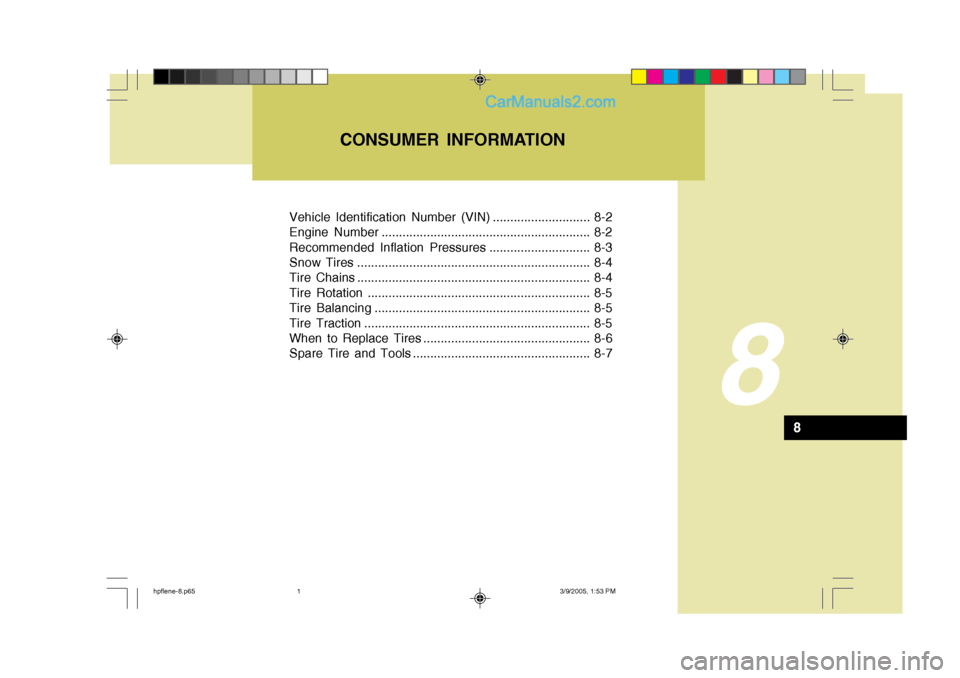
Vehicle Identification Number (VIN) ............................ 8-2
Engine Number ............................................................ 8-2
Recommended Inflation Pressures ............................. 8-3
Snow Tires ................................................................... 8-4
Tire Chains ................................................................... 8-4
Tire Rotation ................................................................ 8-5
Tire Balancing .............................................................. 8-5
Tire Traction ................................................................. 8-5
When to Replace Tires ................................................ 8-6
Spare Tire and Tools ................................................... 8-7
8
CONSUMER INFORMATION
8
hpflene-8.p653/9/2005, 1:53 PM
1
Page 282 of 539
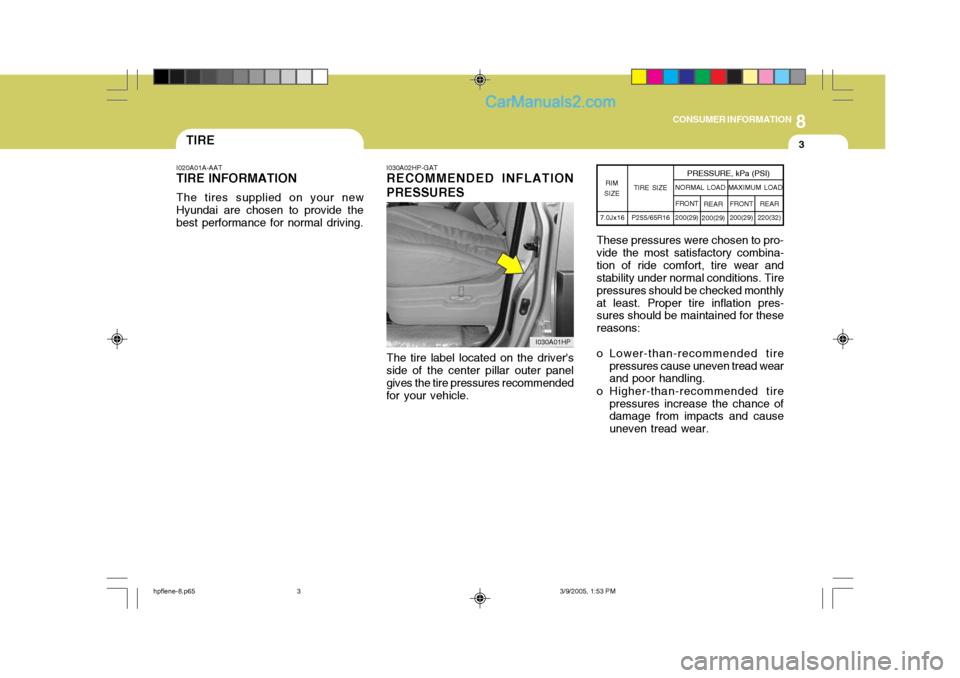
8
CONSUMER INFORMATION
3TIRE
I020A01A-AAT
TIRE INFORMATION
The tires supplied on your new
Hyundai are chosen to provide the best performance for normal driving. I030A02HP-GAT RECOMMENDED INFLATION PRESSURES
The tire label located on the driver's
side of the center pillar outer panel gives the tire pressures recommended for your vehicle. 7.0Jx16
TIRE SIZE
RIM
SIZE PRESSURE, kPa (PSI)
P255/65R16 REAR
200(29) FRONT
200(29)
NORMAL LOAD MAXIMUM LOAD
REAR
220(32)
FRONT
200(29)
These pressures were chosen to pro- vide the most satisfactory combina-tion of ride comfort, tire wear and stability under normal conditions. Tire pressures should be checked monthlyat least. Proper tire inflation pres- sures should be maintained for these reasons:
o Lower-than-recommended tire pressures cause uneven tread wear and poor handling.
o Higher-than-recommended tire pressures increase the chance ofdamage from impacts and cause uneven tread wear.
I030A01HP
hpflene-8.p65
3/9/2005, 1:53 PM
3
Page 288 of 539
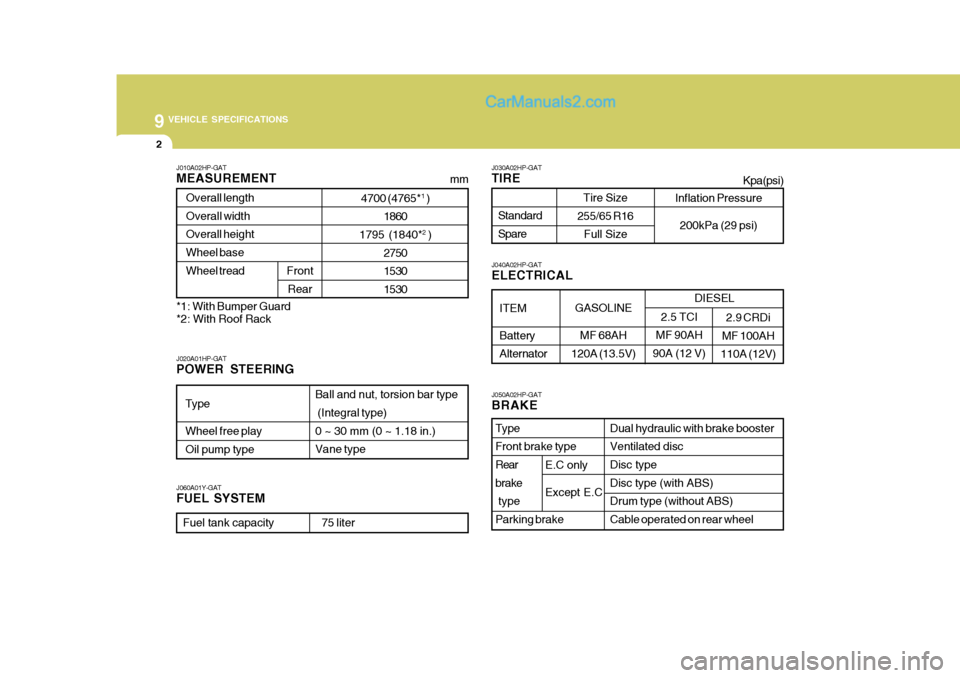
9 VEHICLE SPECIFICATIONS
2
J010A02HP-GAT MEASUREMENT
4700 (4765* 1
)
1860
1795 (1840* 2
)
2750 15301530
Overall length Overall width Overall heightWheel base Wheel tread
Front
Rear
Type Wheel free play Oil pump type Ball and nut, torsion bar type (Integral type) 0 ~ 30 mm (0 ~ 1.18 in.)Vane type
J060A01Y-GAT FUEL SYSTEM
J020A01HP-GAT POWER STEERING J030A02HP-GAT TIRE
Standard Spare
J050A02HP-GAT BRAKE Dual hydraulic with brake booster Ventilated disc Disc type Disc type (with ABS)Drum type (without ABS) Cable operated on rear wheel
Type Front brake type Rear brake type Parking brake
ITEM Battery Alternator
J040A02HP-GAT ELECTRICAL
mm
Fuel tank capacity 75 liter
2.5 TCI
MF 90AH
90A (12 V)
Tire Size
255/65 R16 Full Size Kpa(psi)
2.9 CRDi
MF 100AH
110A (12V)GASOLINE
MF 68AH
120A (13.5V)DIESEL
E.C only Except E.C*1: With Bumper Guard *2: With Roof Rack Inflation Pressure
200kPa (29 psi)
Page 350 of 539
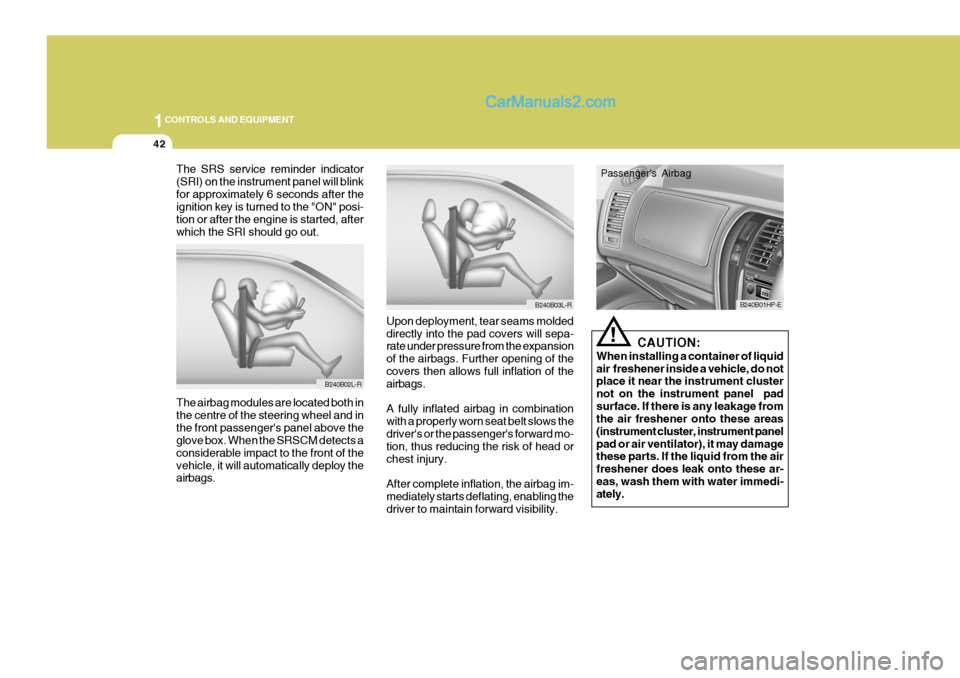
1CONTROLS AND EQUIPMENT
42
The SRS service reminder indicator (SRI) on the instrument panel will blinkfor approximately 6 seconds after the ignition key is turned to the "ON" posi- tion or after the engine is started, afterwhich the SRI should go out.
Upon deployment, tear seams moldeddirectly into the pad covers will sepa- rate under pressure from the expansion of the airbags. Further opening of the covers then allows full inflation of the airbags. A fully inflated airbag in combination with a properly worn seat belt slows thedriver's or the passenger's forward mo-
tion, thus reducing the risk of head or chest injury. After complete inflation, the airbag im- mediately starts deflating, enabling thedriver to maintain forward visibility.
The airbag modules are located both inthe centre of the steering wheel and inthe front passenger's panel above the glove box. When the SRSCM detects a considerable impact to the front of thevehicle, it will automatically deploy the airbags.
B240B02L-R
B240B03L-R
!
CAUTION:
When installing a container of liquid air freshener inside a vehicle, do not place it near the instrument cluster not on the instrument panel padsurface. If there is any leakage from the air freshener onto these areas (instrument cluster, instrument panelpad or air ventilator), it may damage these parts. If the liquid from the air freshener does leak onto these ar-eas, wash them with water immedi- ately.
B240B01HP-E
Passenger's Airbag
Page 439 of 539
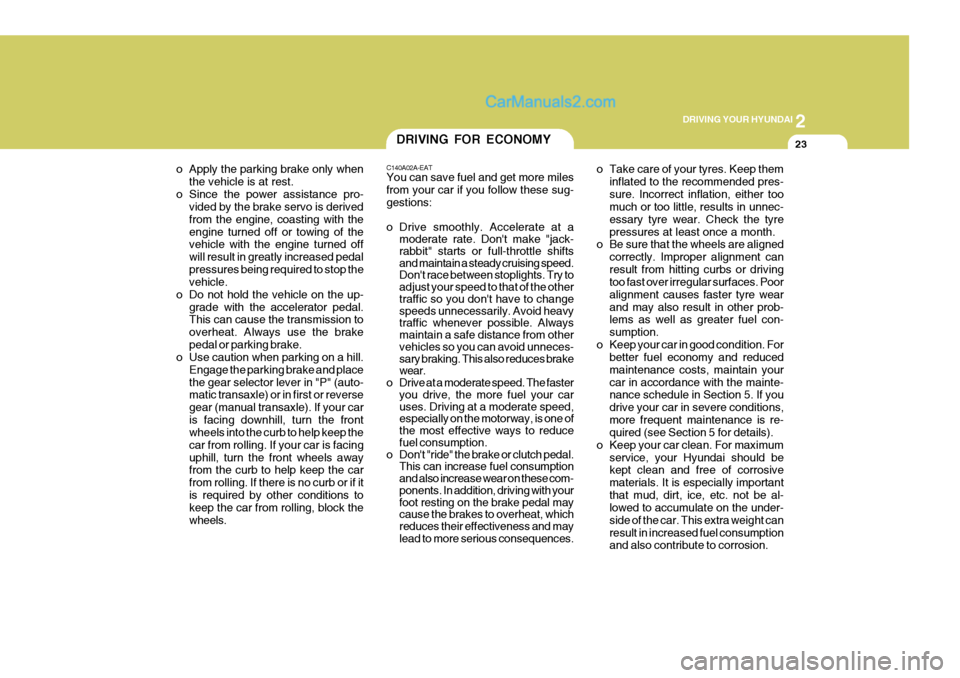
2
DRIVING YOUR HYUNDAI
23
o Apply the parking brake only when the vehicle is at rest.
o Since the power assistance pro- vided by the brake servo is derived from the engine, coasting with theengine turned off or towing of the vehicle with the engine turned off will result in greatly increased pedalpressures being required to stop the vehicle.
o Do not hold the vehicle on the up- grade with the accelerator pedal.This can cause the transmission to overheat. Always use the brakepedal or parking brake.
o Use caution when parking on a hill.
Engage the parking brake and placethe gear selector lever in "P" (auto- matic transaxle) or in first or reverse gear (manual transaxle). If your caris facing downhill, turn the front wheels into the curb to help keep the car from rolling. If your car is facinguphill, turn the front wheels away from the curb to help keep the car from rolling. If there is no curb or if itis required by other conditions to keep the car from rolling, block the wheels.DRIVING FOR ECONOMY
C140A02A-EAT You can save fuel and get more miles from your car if you follow these sug-gestions:
o Drive smoothly. Accelerate at a moderate rate. Don't make "jack- rabbit" starts or full-throttle shifts and maintain a steady cruising speed. Don't race between stoplights. Try to adjust your speed to that of the other traffic so you don't have to change speeds unnecessarily. Avoid heavy traffic whenever possible. Always maintain a safe distance from other vehicles so you can avoid unneces- sary braking. This also reduces brake wear.
o Drive at a moderate speed. The faster you drive, the more fuel your car uses. Driving at a moderate speed, especially on the motorway, is one of the most effective ways to reduce fuel consumption.
o Don't "ride" the brake or clutch pedal. This can increase fuel consumption and also increase wear on these com- ponents. In addition, driving with your foot resting on the brake pedal may cause the brakes to overheat, which reduces their effectiveness and may lead to more serious consequences. o Take care of your tyres. Keep them
inflated to the recommended pres- sure. Incorrect inflation, either too much or too little, results in unnec- essary tyre wear. Check the tyrepressures at least once a month.
o Be sure that the wheels are aligned
correctly. Improper alignment canresult from hitting curbs or driving too fast over irregular surfaces. Poor alignment causes faster tyre wearand may also result in other prob- lems as well as greater fuel con- sumption.
o Keep your car in good condition. For better fuel economy and reducedmaintenance costs, maintain yourcar in accordance with the mainte- nance schedule in Section 5. If you drive your car in severe conditions,more frequent maintenance is re- quired (see Section 5 for details).
o Keep your car clean. For maximum service, your Hyundai should bekept clean and free of corrosive materials. It is especially importantthat mud, dirt, ice, etc. not be al- lowed to accumulate on the under- side of the car. This extra weight canresult in increased fuel consumption and also contribute to corrosion.
Page 452 of 539
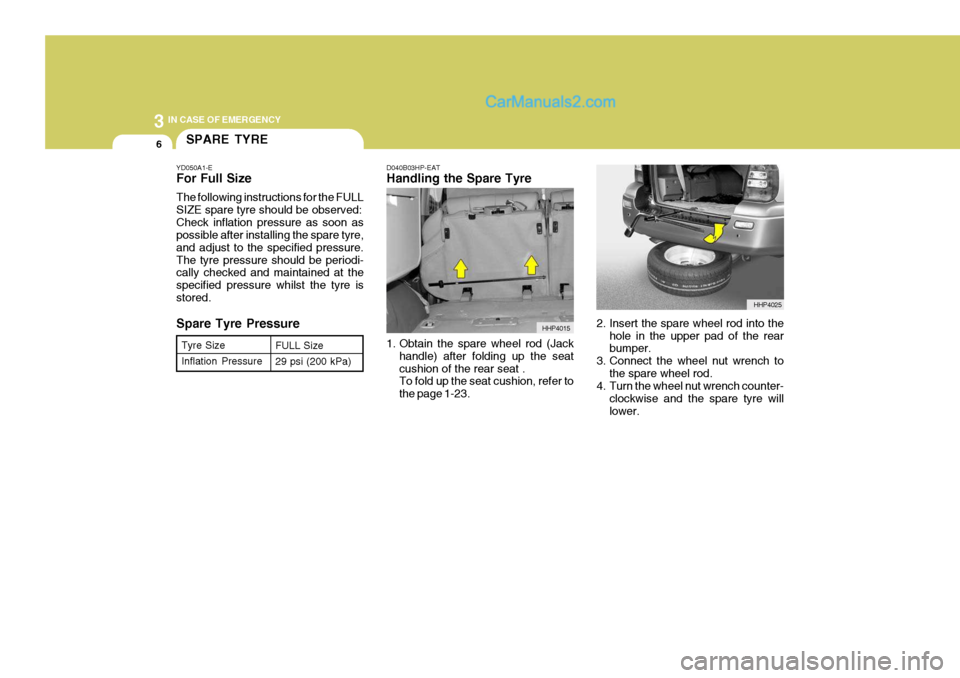
3 IN CASE OF EMERGENCY
6
D040B03HP-EAT Handling the Spare Tyre
1. Obtain the spare wheel rod (Jackhandle) after folding up the seat cushion of the rear seat . To fold up the seat cushion, refer to the page 1-23. 2. Insert the spare wheel rod into the
hole in the upper pad of the rear bumper.
3. Connect the wheel nut wrench to the spare wheel rod.
4. Turn the wheel nut wrench counter-
clockwise and the spare tyre will lower.
Tyre Size Inflation Pressure
FULL Size 29 psi (200 kPa)SPARE TYRE
YD050A1-E For Full Size The following instructions for the FULL SIZE spare tyre should be observed:Check inflation pressure as soon as possible after installing the spare tyre, and adjust to the specified pressure.The tyre pressure should be periodi- cally checked and maintained at the specified pressure whilst the tyre isstored. Spare Tyre Pressure
HHP4015
HHP4025
Page 531 of 539
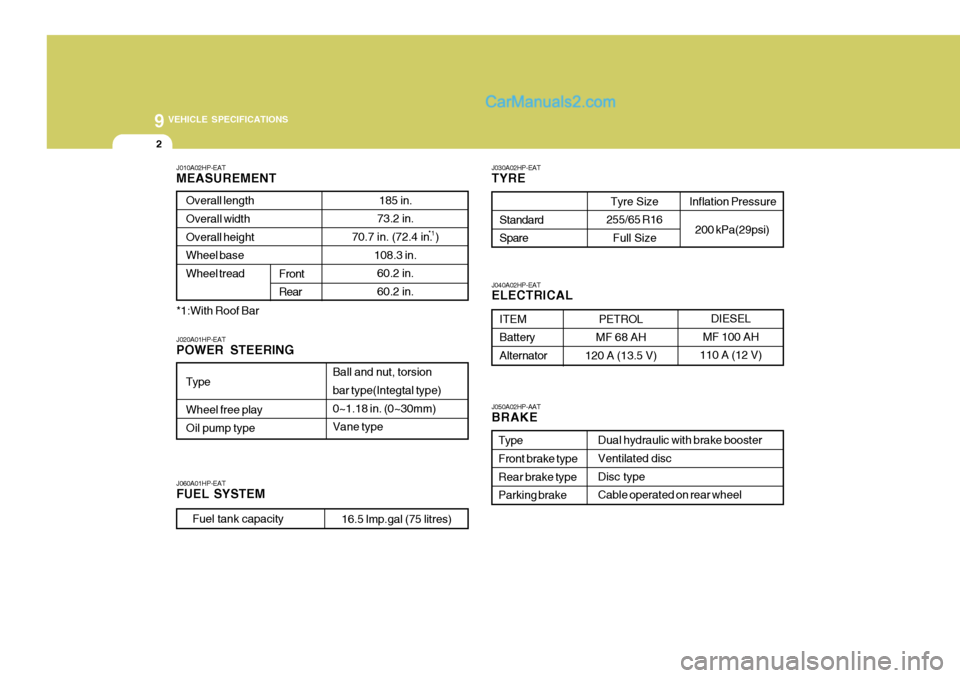
9 VEHICLE SPECIFICATIONS
2
PETROL
MF 68 AH
120 A (13.5 V)
J010A02HP-EAT MEASUREMENT
185 in.
73.2 in.
70.7 in. (72.4 in. )
108.3 in.60.2 in. 60.2 in.
Overall lengthOverall width Overall height Wheel baseWheel tread
Front Rear
J060A01HP-EAT FUEL SYSTEM J030A02HP-EATTYRE
Standard Spare
J050A02HP-AAT BRAKE Dual hydraulic with brake booster Ventilated disc Disc typeCable operated on rear wheel
TypeFront brake type Rear brake type Parking brake
ITEM Battery Alternator
J040A02HP-EAT ELECTRICAL
Fuel tank capacity
DIESEL
MF 100 AH
110 A (12 V)
Tyre Size
255/65 R16
Full Size
16.5 lmp.gal (75 litres)
*1:With Roof Bar
*1
Type
Ball and nut, torsion bar type(Integtal type) 0~1.18 in. (0~30mm) Vane type
J020A01HP-EAT POWER STEERING
Wheel free play Oil pump type
Inflation Pressure
200 kPa(29psi)